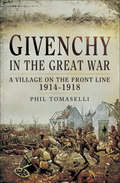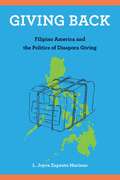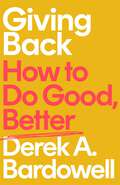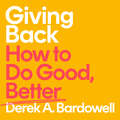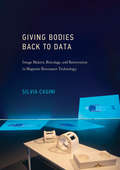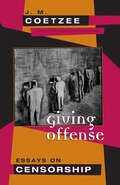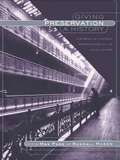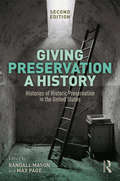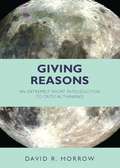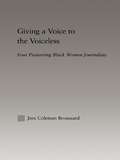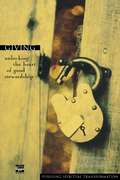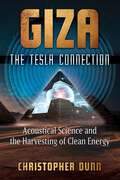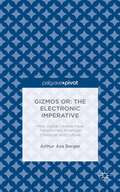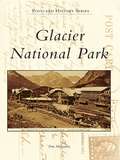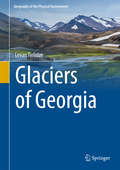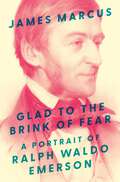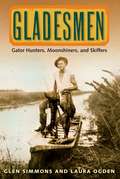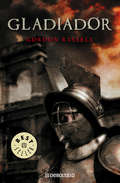- Table View
- List View
Givenchy in the Great War: A Village on the Front Line, 1914–1918
by Phil TomaselliThe village of Givenchy-ls-la-Basse sits on a small rise in the Pas de Calais Department in northern France. One hundred years ago it was overtaken by the First World War. The fighting there was intense eleven Victoria Crosses were won in this tiny locality between 1914 and 1918. Phil Tomasellis in-depth account shows what happened at Givenchy when it became a battlefield, and the story here was repeated in the other villages and towns on the Western Front. Givenchys key position made it the target for crushing bombardments, infantry assaults and subterranean warfare. The landscape was pulverized by shellfire, the ground beneath was honeycombed with tunnels. Mining operations, shelling, sniping and trench raids took place around the remains of the village even when this stretch of the front line was relatively quiet. The grueling struggle of attrition that characterized the fighting on the Western Front continued here throughout the war. Phil Tomasellis gripping narrative makes extensive use of war diary extracts, personal stories, official and unofficial histories.
Giving A Damn: Racism, Romance And Gone With The Wind
by Patricia Williams‘I cannot help but see the bodies of my near ancestors in the current caravans of desperate souls fleeing from place to place, chased by famine, war and toxins. Ideas honed in slavery – of the otherness, the boorishness, the inferiority of thy neighbour – have continued to travel through American society.’ The story of slavery in America is not over. It lives on in how we speak to one another, in how we treat one another, in how our societies are organised. In Giving a Damn, the legal scholar Patricia Williams finds that when you begin to unpick current debates around immigration, freedom of speech, the culture wars and wall-building, beneath them lies the unexamined history of enslavement in the West. Our ability to dehumanize one another can be traced all the way from the plantation to the US President’s Twitter account.
Giving Back: Filipino America and the Politics of Diaspora Giving (Asian American History & Cultu #222)
by L. Joyce MarianoMany Filipino Americans feel obligated to give charitably to their families, their communities, or social development projects and organizations back home. Their contributions provide relief to poor or vulnerable Filipinos, and address the forces that maintain poverty, vulnerability, and exploitative relationships in the Philippines. This philanthropy is a result of both economic globalization and the migration of Filipino professionals to the United States. But it is also central to the moral economies of Filipino migration, immigration, and diasporic return. Giving-related practices and concerns—and the bonds maintained through giving—infuse what it means to be Filipino in America. Giving Back shows how integral this system is for understanding Filipino diaspora formation. Joyce Mariano “follows the money” to investigate the cultural, social, economic, and political conditions of diaspora giving. She takes an interdisciplinary approach to reveal how power operates through this charity and the ways the global economic and cultural dimensions of this practice reinforce racial subordination and neocolonialism. Giving Back explores how this charity can stabilize overlapping systems of inequality as well as the contradictions of corporate social responsibility programs in diaspora.
Giving Back: Filipino America and the Politics of Diaspora Giving (Asian American History & Cultu #222)
by L. Joyce MarianoMany Filipino Americans feel obligated to give charitably to their families, their communities, or social development projects and organizations back home. Their contributions provide relief to poor or vulnerable Filipinos, and address the forces that maintain poverty, vulnerability, and exploitative relationships in the Philippines. This philanthropy is a result of both economic globalization and the migration of Filipino professionals to the United States. But it is also central to the moral economies of Filipino migration, immigration, and diasporic return. Giving-related practices and concerns—and the bonds maintained through giving—infuse what it means to be Filipino in America. Giving Back shows how integral this system is for understanding Filipino diaspora formation. Joyce Mariano “follows the money” to investigate the cultural, social, economic, and political conditions of diaspora giving. She takes an interdisciplinary approach to reveal how power operates through this charity and the ways the global economic and cultural dimensions of this practice reinforce racial subordination and neocolonialism. Giving Back explores how this charity can stabilize overlapping systems of inequality as well as the contradictions of corporate social responsibility programs in diaspora.
Giving Back: How to Do Good, Better
by Derek A. BardowellDo you wish you could do more to change the world but don't know how? Do you ever look around at the many charities asking for donations and feel overwhelmed? This inspiring and uplifting book explores the effectiveness of charity and calls for more radical giving if we want to contribute to a better world. During a period when British society seems more divided than ever, and our decision makers are even more disconnected from the issues that keep us awake at night, Giving Back highlights the people and movements taking on some of the most challenging social issues of our time.A respected figure in philanthropy, Derek A. Bardowell presents a unique insight into what's going on inside the world of giving and where we can best make a difference.From redefining the role of charity itself to reimagining philanthropy through a reparative lens, Bardowell introduces a radical new take on how social problems, from climate change to racial injustice, can be tackled in modern society by all of us.Filled with lively insights and moving stories, Giving Back is here to break down the walls of charitable giving. If you loved Factfulness, Lost Connections, and What White People Can Do Next, this book will challenge some of your truths and change the way you give.What people are saying about Derek A. Bardowell:'Personal, political, powerful.' Bernardine Evaristo'Important and timely... Deeply felt and illuminating... Essential reading for everyone committed to fairness and equality in life.' Goodreads Reviewer, 5 stars'A valuable act of remembrance... While wealth may confer privileges, it doesn't rid you of melanin or exempt you from prejudice.' Colin Grant, Guardian'Bardowell does an excellent and passionate job of refracting the issues.' Financial Times'I absolutely loved it!... Such a good read on so many levels.' Goodreads Reviewer, 5 stars
Giving Back: How to Do Good, Better
by Derek A. BardowellDo you wish you could do more to change the world but don't know how? Do you ever look around at the many charities asking for donations and feel overwhelmed? This inspiring and uplifting book explores the effectiveness of charity and calls for more radical giving if we want to contribute to a better world. During a period when British society seems more divided than ever, and our decision makers are even more disconnected from the issues that keep us awake at night, Giving Back highlights the people and movements taking on some of the most challenging social issues of our time.A respected figure in philanthropy, Derek A. Bardowell presents a unique insight into what's going on inside the world of giving and where we can best make a difference.From redefining the role of charity itself to reimagining philanthropy through a reparative lens, Bardowell introduces a radical new take on how social problems, from climate change to racial injustice, can be tackled in modern society by all of us.Filled with lively insights and moving stories, Giving Back is here to break down the walls of charitable giving. If you loved Factfulness, Lost Connections, and What White People Can Do Next, this book will challenge some of your truths and change the way you give.What people are saying about Derek A. Bardowell:'Personal, political, powerful.' Bernardine Evaristo'Important and timely... Deeply felt and illuminating... Essential reading for everyone committed to fairness and equality in life.' Goodreads Reviewer, 5 stars'A valuable act of remembrance... While wealth may confer privileges, it doesn't rid you of melanin or exempt you from prejudice.' Colin Grant, Guardian'Bardowell does an excellent and passionate job of refracting the issues.' Financial Times'I absolutely loved it!... Such a good read on so many levels.' Goodreads Reviewer, 5 stars
Giving Bodies Back to Data: Image Makers, Bricolage, and Reinvention in Magnetic Resonance Technology (Leonardo)
by Silvia CasiniAn examination of the bodily, situated aspects of data-visualization work, looking at visualization practices around the development of MRI technology.Our bodies are scanned, probed, imaged, sampled, and transformed into data by clinicians and technologists. In this book, Silvia Casini reveals the affective relations and materiality that turn data into image--and in so doing, gives bodies back to data. Opening the black box of MRI technology, Casini examines the bodily, situated aspects of visualization practices around the development of this technology. Reframing existing narratives of biomedical innovation, she emphasizes the important but often overlooked roles played by aesthetics, affectivity, and craft practice in medical visualization. Combining history, theory, laboratory ethnography, archival research, and collaborative art-science, Casini retrieves the multiple presences and agencies of bodies in data visualization, mapping the traces of scientists' body work and embodied imagination. She presents an in-depth ethnographic study of MRI development at the University of Aberdeen's biomedical physics laboratory, from the construction of the first whole-body scanner for clinical purposes through the evolution of the FFC-MRI. Going beyond her original focus on MRI, she analyzes a selection of neuroscience- or biomedicine-inspired interventions by artists in media ranging from sculpture to virtual reality. Finally, she presents a methodology for designing and carrying out small-scale art-science projects, describing a collaboration that she herself arranged, highlighting the relational and aesthetic-laden character of data that are the product of craftsmanship and affective labor at the laboratory bench.
Giving Credit to Dictatorship: Authoritarian Regimes and Financial Capitalism in Europe during the Twentieth Century (Routledge Studies in Fascism and the Far Right)
by José Luís Cardoso Valerio TorreggianiThis edited volume explores the interplay between political, economic, and financial development in twentieth-century European authoritarian regimes.The book features case studies that explore the impact of domestic and international finance on the rise, stabilization, and decline of various European dictatorships of the twentieth century, such as Italy, Germany, Yugoslavia, Portugal, Spain, Greece, and Turkey. The chapters delve into the role that the regimes played in shaping and transforming the financial system, exploring their international interconnections as well as the influence of economic theory and ideological constructs in dictatorial environments. Applying the methodological framework of the history of capitalism to the analysis of the relationship between authoritarian regimes and financial systems, the book provides new insights into the relationshipsbetween politics and economics, and it offers a fresh perspective on contemporary political issues and their interaction with the global financial system.This collection is an ideal resource for postgraduate students and researchers in history, economics, political economy, and political sciences.
Giving Offense: Essays on Censorship
by J. M. CoetzeeJ.M. Coetzee presents a coherent, unorthodox analysis of censorship from the perspective of one who has lived and worked under its shadow. The essays collected here attempt to understand the passion that plays itself out in acts of silencing and censoring. He argues that a destructive dynamic of belligerence and escalation tends to overtake the rivals in any field ruled by censorship.
Giving Preservation a History
by Randall Mason Max PageIn this volume, some of the best figures in the field have come together to write on preservation movements across the country, from New York to Atlanta to Santa Fe and others. Giving Preservation a History also touches on the European roots of the historic preservation movement; on how preservation movements have taken a leading role in shaping American urban space and urban development; how historic preservation battles have reflected broader social forces; and what the changing nature of historic preservation means for the effort to preserve the nation's past.
Giving Preservation a History: Histories of Historic Preservation in the United States
by Randall Mason Max PageIn this volume, some of the leading figures in the field have been brought together to write on the roots of the historic preservation movement in the United States, ranging from New York to Santa Fe, Charleston to Chicago. Giving Preservation a History explores the long history of historic preservation; how preservation movements have taken a leading role in shaping American urban space and development; how historic preservation battles have reflected broader social forces; and what the changing nature of historic preservation means for efforts to preserve national, urban and local heritage. The second edition adds several new essays addressing key developing areas in the field by major new voices. The new essays represent the broadening range of scholarship on historic preservation generated since the publication of the first edition, taking better account of the role of cultural diversity and difference within the field while exploring the connections between preservation and allied concerns such as environmental sustainability, LGBTQ and nonwhite identity, and economic development.
Giving Reasons: An Extremely Short Introduction to Critical Thinking
by David R. MorrowGiving Reasons prepares students to think independently, evaluate information, and reason clearly across disciplines. Accessible to students and effective for instructors, it provides plain-English exercises, helpful appendices, and a variety of online supplements.
Giving Thanks: How Thanksgiving Became a National Holiday
by Denise KiernanThe beautifully illustrated true story of how Thanksgiving became a national holiday in America, of Sarah Josepha Hale, the woman who made the holiday happen, and of the role of gratitude the world over. Marvelously brought to life by the New York Times bestselling author Denise Kiernan.All across the world, among hundreds of cultures and across centuries, people have come together to give thanks. But Americans didn&’t have an official Thanksgiving holiday until the 1800s. The holiday Americans know today exists because of a woman named Sarah Josepha Hale, a spirited letter-writing campaign, a sympathetic president, and a civil war. This beautifully illustrated picture book shares the true story of how Thanksgiving became a national American holiday and offers a look at the timeless and global power of gratitude.
Giving Voice: The Power of Theatre for Positive Change (ISSN)
by Carol J. MaplesThis book is a practical guide for using the power of theatre to address issues of oppression in areas such as race, ethnicity, LGBTQ+, gender, and sexual harassment.Giving Voice charts a roadmap for the process of establishing a troupe, including auditioning members, utilizing authentic source material, directing rehearsals, guiding mindful growth among troupe members, and facilitating an inclusive forum environment. Rooted in Augusto Boal’s Theatre of the Opressed and using the nationally recognized Missouri State University’s Giving Voice troupe as a model, this book provides guidance for customizing the program’s principles to meet the needs of your school, community, organization, or business. Giving Voice forums bring professional development to a new level. Applications include diversity and cultural awareness training in educational settings for students, staff, faculty, and administrators, as well as those in non-profit and for-profit organizations.This book provides a powerful and proven approach to creating a truly inclusive climate. It is a guidebook for accessible use in the secondary and university setting in theatre and performance studies. It has also been shown to be effective for businesses and other organizations.
Giving a Voice to the Voiceless: Four Pioneering Black Women Journalists (Studies In African American History And Culture Ser.)
by Jinx Coleman BroussardThis work describes the journalism careers of four black women within the context of the period in which they lived and worked. Ida B. Wells-Barnett, Mary Church Terrell, Alice Dunbar-Nelson and Amy Jacques Garvey were among a group of approximately twenty black women journalists who wrote for newspapers, magazines and other media during the late n
Giving: Unlocking the Heart of Good Stewardship (Pursuing Spiritual Transformation)
by John Ortberg Laurie Pederson Judson PolingJesus said more about money than just about any other topic. Clearly, it is an important issue--and a touchy one! Deep down, we know it is not a matter of what we earn but how we manage what we earn that shows our ultimate priorities.Giving demonstrates how good stewardship is more than a responsibility—it’s an adventure. As you study the connection between your wallet and your heart, you’ll learn how money management is a powerful tool for shaping your character. You’ll discover how giving is as much a part of spiritual growth as prayer and Bible study. And you’ll learn about the rewards of cultivating wise financial habits and a generous heart. Above all, you’ll find out how a lifestyle of giving reflects the heart of God, who freely gives his best to you.Leader’s guide included!Giving group sessions are:Money: Why Is It So Important to God?The Open Hands of GodTithing: A Training Exercise for the HeartBehind the Scenes of DebtWhat Is a Biblical Lifestyle?Cultivating a Heart of CompassionThe Chance of a Lifetime
Giza: Acoustical Science and the Harvesting of Clean Energy
by Christopher DunnReveals how the pyramids of Egypt were sophisticated generators of clean energy• Explains how the pyramids harmonized seismic energy, which enabled the harvesting of electricity and the mitigation of earthquakes• Shares recent cutting-edge research on earthquake lights, acoustic frequency measurements and energy concentration within the Great Pyramid, the shafts of the Queen&’s Chamber, the scorch marks that support the King&’s Chamber explosion hypothesis, and the significance of the large void above the Grand Gallery• Includes technical appendices written by experts and top researchersSharing extensive new evidence and cutting-edge research that the Great Pyramid at Giza was built as an energy-harvesting machine, Christopher Dunn details how the ancient Egyptians generated clean power for their civilization and reveals how the pyramid builders and the great inventor Nikola Tesla drew from the same universal knowledge. Looking at each part of the Great Pyramid, from the internal chambers to its massive stone blocks to the pyramidion on top, Dunn reveals how the pyramids in Egypt served to stimulate the release and collection of electrons in the Earth&’s crust by harmonizing seismic energy while also attenuating the accumulating stresses. Drawing on exhaustive ongoing research by NASA scientists into the phenomenon known as &“earthquake lights,&” Dunn shows how the pyramid builders were inspired by this phenomenon and learned to stress igneous rocks in order to harvest the resulting electron flow. He looks in depth at recent research that supports the pyramid energy theory, including new explorations of the shafts of the Queen&’s Chamber and analysis of the scorch marks on the ceiling of the Grand Gallery, which supports the King&’s Chamber explosion hypothesis. He examines the stunning significance of the large void above the Grand Gallery discovered in 2017. Dunn also analyses the results of extensive acoustic testing and measurements at ancient sacred sites and shows how the pyramids were tuned to the Earth&’s frequency. While the pyramids&’ sophisticated energy-harvesting abilities are now in disarray and disuse, some remnants of their technologies are still there, waiting to be rediscovered and provide our civilization with an abundance of nonpolluting power.
Gizmos or: How Digital Devices Have Transformed American Character And Culture
by Arthur BergerGizmos or: The Electronic Imperative offers a concise series of analyses on the transformative impact of digital devices on American society. With approaches ranging from semiotic theory to psychoanalytic theory, sociological theory to personal reflection, Berger taps the span of knowledge from his prolific career to help readers better understand the role digital devices play both in their technologic, economic, and common-use forms. Using accessible, conversational language and numerous illustrations, Berger deconstructs familiar objects and media for readers ranging from field specialists to everyday cultural consumers alike.
Già sua (Le cronache dei Caversham, libro #2)
by F. Rossi Sandy RavenLo ama da tutta una vita. Lady Elise Halden sa come far piegare al suo volere i cavalli, con il suo tocco gentile e persuasivo, ma sta imparando che farsi obbedire dal nuovo conte di Camden non è paragonabile ad addestrare una cavalcatura. Se vuole una qualche speranza di imbrigliare gli affetti del conte, le servirà un piano. Con l'aiuto della sua amica lady Beverly e di sua cognata, la duchessa, Elise si prefigge di vincere il cuore del suo indifferente conte. Lui l'ha sempre ammirata da una rispettosa distanza. Da ragazzi, Michael Brightman e il suo migliore amico hanno giurato di lasciar perdere le rispettive sorelle, una promessa fatta solo per proteggere la sua dai modi affascinanti e libertini dell'amico. La sorellina del duca di Caversham è sempre stata una sfacciatella precoce da evitare, finché un giorno Michael si accorge che lady Elise è cresciuta, e le cose che vorrebbe fare con lei di certo metterebbero a repentaglio l'amicizia con suo fratello. Insieme scoprono che le prove fisiche non corrispondono necessariamente alla verità e che fidarsi del cuore a volte è la lezione più difficile da imparare. Il romanzo è il secondo della serie "Le cronache dei Caversham", dopo "La sposa di Caversham" e il prequel, "Miss Amelia accalappia un duca", entrambi già disponibili in tutti gli store. Pur non essendo prettamente un erotico, contiene scene di sesso. Le date di pubblicazione dei prossimi volumi: Libro terzo: "L'amore di Sarah", disponibile dal dicembre 2015 Libro quarto: "La signora di Lucky", disponibile dal febbraio 2016
Glacier National Park
by Bill YenneGlacier National Park is a majestic million acres of towering mountains, ancient glaciers, and amazing biodiversity. Located astride both the Continental Divide and Hudson Bay Divide, Glacier contains Triple Divide Peak, the only point in North America from which the waters drain into three oceans. The land that George Bird Grinnell called the "Crown of the Continent" and that John Muir described as "the best care-killing scenery on the continent" has beendelighting visitors since well before it was set aside as a park in 1910. Through the years, countless people have come to Glacier to hike its nearly thousand miles of trails, marvel at its unrivalled scenery, and drive the Going-to-the-Sun Road, America's most spectacular alpine highway. Glacier is also home to remote mountain chalets and magnificent grand lodges. While most national parks have a singular signature lodge, Glacier has three.
Glacier National Park
by Tom MulvaneyPres. William Howard Taft signed the bill creating Glacier National Park in 1910, and a wilderness paradise in northwestern Montana was born. This book illustrates the park's evolution, from the Great Northern Railroad days, Native American presence, lodges, chalets, and camps, to majestic scenery and wildlife--all in vintage postcards. The opening of Glacier National Park coincided with the popularity of postcards across the nation, and hence this visual documentation of Glacier's many wonders is thorough and encompassing. With the celebration of its centennial in 2010, Glacier National Park continues to provide us with one of the last best places to visit.
Glaciers of Georgia
by Levan TielidzeThis book gives the most detailed and comprehensive insights into the morphology, morphometry and dynamics of glaciers in the Georgian Caucasus region up to date. It examines the variability of valley glaciers after the Little Ice Age maximum and identifies glacial dynamics during historical periods. The reconstruction of glaciation in the Late Pleistocene and Holocene was conducted based on long lasting detailed glacial-geomorphological observations by the author. It further analyses moraine structures, river terraces, geodynamics of the relief, and snow and firn line locations derived from field surveys in most glacier basins in the southern and northern slopes of the Georgian Caucasus. A whole set of methodological approaches was applied including remote sensing and GIS, glacio-geomorphological, cartographical, aerial image processing and petrographic methods, unveiling accurate information about glaciers difficult to access, e. g. in the Abkhazeti and Tskhinvali regions. The book provides a full database of Georgia's modern glaciation and displays a set of compiled maps of the distribution of the Late Pleistocene glaciation of the Georgian Caucasus.
Glad to the Brink of Fear: A Portrait of Ralph Waldo Emerson
by James MarcusAn engaging reassessment of the celebrated essayist and his relevance to contemporary readersMore than two centuries after his birth, Ralph Waldo Emerson remains one of the presiding spirits in American culture. Yet his reputation as the starry-eyed prophet of self-reliance has obscured a much more complicated figure who spent a lifetime wrestling with injustice, philosophy, art, desire, and suffering. James Marcus introduces readers to this Emerson, a writer of self-interrogating genius whose visionary flights are always grounded in Yankee shrewdness.This Emerson is a rebel. He is also a lover, a friend, a husband, and a father. Having declared his great topic to be &“the infinitude of the private man,&” he is nonetheless an intensely social being who develops Transcendentalism in the company of Henry David Thoreau, Margaret Fuller, Bronson Alcott, and Theodore Parker. And although he resists political activism early on—hoping instead for a revolution in consciousness—the burning issue of slavery ultimately transforms him from cloistered metaphysician to fiery abolitionist.Drawing on telling episodes from Emerson&’s life alongside landmark essays like &“Self-Reliance,&” &“Experience,&” and &“Circles,&” Glad to the Brink of Fear reveals how Emerson shares our preoccupations with fate and freedom, race and inequality, love and grief. It shows, too, how his desire to see the world afresh, rather than accepting the consensus view, is a lesson that never grows old.
Gladesmen: Gator Hunters, Moonshiners, and Skiffers (Florida History and Culture)
by Glen Simmons Laura OgdenFew people today can claim a living memory of Florida's frontier Everglades. Glen Simmons, who has hunted alligators, camped on hammock-covered islands, and poled his skiff through the mangrove swamps of the glades since the 1920s, is one who can. Together with Laura Ogden, he tells the story of backcountry life in the southern Everglades from his youth until the establishment of the Everglades National Park in 1947.During the economic bust of the late ‘20s, when many natives turned to the land to survive, Simmons began accompanying older local men into Everglades backcountry, the inhospitable prairie of soft muck and mosquitoes, of outlaws and moonshiners, that rings the southern part of the state. As Simmons recalls life in this community with humor and nostalgia, he also documents the forgotten lifestyles of south Florida gladesmen.By necessity, they understood the natural features of the Everglades ecosystem. They observed the seasonal fluctuations of wildlife, fire, and water levels. Their knowledge of the mostly unmapped labyrinth of grassy water enabled them to serve as guides for visiting naturalists and scientists. Simmons reconstructs this world, providing not only fascinating stories of individual personalities, places, and events, but an account that is accurate, both scientifically and historically, of one of the least known and longest surviving portions of the American frontier.
Gladiador
by Gordon RussellUna recreación magistral del fascinante mundo de los gladiadores, el espectáculo bárbaro y sangriento que apasionó a la sociedad de la Roma imperial: un juego macabro en el que el combate es la única forma de sobrevivir... y, para algunos, de vengarse. De pie, en la arena, con los ojos entrecerrados, Orfeo escucha los gritos ensordecedores de la turba sedienta de sangre. Al fondo, dos puertas: una dará salida al vencedor, la otra al cuerpo sin vida del vencido. Año 68 d.C. Nerón ha muerto y cuatro hombres se disputan la sucesión del Imperio en una cruenta guerra civil. En esos tiempos turbulentos, Vitelio, gobernador de Germania y aspirante a emperador, visita a una sacerdotisa, que le augura una muerte temprana: alguien llamado Orfeo será el instrumento del destino. Aterrado por la predicción, el gobernador mata a la adivina. El desafortunado Valerio, amante de la sacerdotisa, es acusado de la muerte de su amada; a partir de ese momento, su vida sufre un vuelco: en el mercado de esclavos es vendido al jefe de los gladiadores, bajo el que comienza su formación y transformación en un temible guerrero, cuyas ansias de venganza harán que su nombre destelle sobre la arena del circo. Reseña:«Una exquisitez, sin lugar a dudas, para los apasionados de la antigua Roma.»Loredana Lipperini, La Repubblica
